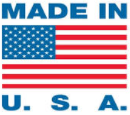Custom Extrusions: Fabrication and Versatile Applications
Created at : Nov 6, 2023
Custom extrusions play a vital role in various industries, offering a versatile and cost-effective solution for creating complex shapes and profiles from a wide range of materials.
Understanding Custom Extrusions
Custom extrusions involve the process of shaping a material by forcing it through a die to create specific cross-sectional profiles. The raw material can vary, including metals, plastics, and rubber, depending on the intended application. The extrusion process is highly versatile and allows for the creation of intricate designs and complex cross-sections that may be challenging to achieve through other manufacturing methods.
Fabrication Process
Material Selection:
The process begins with selecting the appropriate material, depending on the end-use requirements. Metals like aluminum, brass, or steel are common choices for structural components, while plastics, such as PVC or HDPE, are preferred for lightweight, corrosion-resistant applications.
Heating:
The chosen material is heated to a malleable state, usually just above its melting point, making it easier to shape.
Extrusion:
The heated material is forced through a specially designed die, which defines the desired cross-sectional profile. The die can have intricate shapes and sizes, allowing for endless customization possibilities.
Cooling:
After extrusion, the profile is rapidly cooled to solidify the material's shape, ensuring accuracy and dimensional stability.
Cutting and Fabrication:
The extruded profile is cut into the desired lengths and may undergo secondary operations such as punching, bending, or drilling to create more complex shapes and features.
Applications
Custom extrusions find applications in various industries due to their adaptability and cost-effectiveness. Here are some common areas where custom extrusions are utilized:
Construction:
Custom aluminum extrusions are extensively used in the construction industry for window frames, door frames, and curtain walls. Their lightweight yet sturdy properties make them ideal for structural components.
Automotive:
The automotive sector relies on custom extrusions for components like radiator grilles, trim pieces, and structural reinforcements due to their ability to reduce weight and enhance fuel efficiency.
Electronics:
Extruded aluminum and plastic profiles are widely used in the electronics industry for heat sinks, enclosures, and LED lighting fixtures due to their thermal conductivity and electrical insulation properties.
Furniture:
Custom extrusions are employed in the furniture industry for creating intricate and aesthetically pleasing designs. They are often used in chair frames, table legs, and cabinet handles.
Packaging:
Plastic extrusions are integral in the packaging industry for manufacturing custom-shaped containers, trays, and blister packs that provide effective and attractive packaging solutions.
Aerospace:
Aluminum extrusions are essential in the aerospace sector, where lightweight and durable components are critical for aircraft construction, including wing spars and fuselage frames.
Consumer Goods:
Custom extrusions can be found in a wide range of consumer goods, from bicycle frames and sporting equipment to household appliances and shelving systems.
Conclusion
Custom extrusions are an invaluable manufacturing method that offers a myriad of design possibilities across various industries. Their fabrication process, which involves carefully selecting materials, heating, extrusion, cooling, and cutting, ensures that they can be tailored to suit specific applications. With their lightweight and durable characteristics, custom extrusions have become a go-to solution for creating complex shapes, profiles, and components in a cost-effective manner, making them indispensable in the modern manufacturing landscape.

